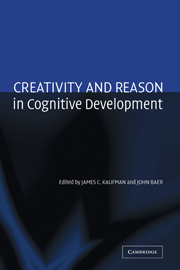Crossref Citations
This Book has been
cited by the following publications. This list is generated based on data provided by Crossref.
Beghetto, Ronald A.
and
Kaufman, James C.
2007.
The genesis of creative greatness: mini‐c and the expert performance approach.
High Ability Studies,
Vol. 18,
Issue. 1,
p.
59.
Kaufman, James C.
and
Sternberg, Robert J.
2007.
Creativity.
Change: The Magazine of Higher Learning,
Vol. 39,
Issue. 4,
p.
55.
2008.
Book received.
Psychological Medicine,
Vol. 38,
Issue. 6,
p.
903.
Baer, John
and
McKool, Sharon S.
2009.
The Psychology of Creative Writing.
p.
277.
Beghetto, Ronald A.
and
Kaufman, James C.
2009.
Intellectual Estuaries: Connecting Learning and Creativity in Programs of Advanced Academics.
Journal of Advanced Academics,
Vol. 20,
Issue. 2,
p.
296.
Gidley, Jennifer M.
2009.
International Handbook of Education for Spirituality, Care and Wellbeing.
Vol. 3,
Issue. ,
p.
553.
Mumford, Michael D.
Hunter, Samuel T.
and
Byrne, Cristina L.
2009.
What Is the Fundamental? The Role of Cognition in Creativity and Innovation.
Industrial and Organizational Psychology,
Vol. 2,
Issue. 3,
p.
353.
Waitman, Grace R.
and
Plucker, Jonathan A.
2009.
The Psychology of Creative Writing.
p.
287.
Kaufman, Allison B.
Kornilov, Sergey A.
Bristol, Adam S.
Tan, Mei
and
Grigorenko, Elena L.
2010.
The Cambridge Handbook of Creativity.
p.
216.
Baer, John
and
Garrett, Tracey
2010.
Nurturing Creativity in the Classroom.
p.
6.
Brodin, Eva M.
and
Frick, Liezel
2011.
Conceptualizing and encouraging critical creativity in doctoral education.
International Journal for Researcher Development,
Vol. 2,
Issue. 2,
p.
133.
DAVIS, CANDICE D.
KAUFMAN, JAMES C.
and
McCLURE, FAITH H.
2011.
Non‐Cognitive Constructs and Self‐Reported Creativity by Domain.
The Journal of Creative Behavior,
Vol. 45,
Issue. 3,
p.
188.
Mumford, Michael D.
Hester, Kimberly S.
Robledo, Issac C.
Peterson, David R.
Day, Eric A.
Hougen, Dean F.
and
Barrett, Jamie D.
2012.
Mental Models and Creative Problem-Solving: The Relationship of Objective and Subjective Model Attributes.
Creativity Research Journal,
Vol. 24,
Issue. 4,
p.
311.
Krampen, Günter
2012.
Cross-Sequential Results on Creativity Development in Childhood Within two Different School Systems: Divergent Performances in Luxembourg Versus German Kindergarten and Elementary School Students.
Europe’s Journal of Psychology,
Vol. 8,
Issue. 3,
p.
423.
Kaniel, Shlomo
2013.
When creativity met transfer.
Gifted Education International,
Vol. 29,
Issue. 1,
p.
13.
Craft, Anna
Cremin, Teresa
Burnard, Pamela
Dragovic, Tatjana
and
Chappell, Kerry
2013.
Possibility thinking: culminative studies of an evidence-based concept driving creativity?.
Education 3-13,
Vol. 41,
Issue. 5,
p.
538.
Hein, Sascha
Tan, Mei
Aljughaiman, Abdullah
and
Grigorenko, Elena L.
2014.
Characteristics of the home context for the nurturing of gifted children in Saudi Arabia.
High Ability Studies,
Vol. 25,
Issue. 1,
p.
23.
Baer, John
and
Garrett, Tracey
2016.
Nurturing Creativity in the Classroom.
p.
45.
Baer, John
2016.
Creativity Doesn't Develop in a Vacuum.
New Directions for Child and Adolescent Development,
Vol. 2016,
Issue. 151,
p.
9.
Gidley, Jennifer M.
2016.
Postformal Education.
p.
229.



